Table of contents
- Tires in MotoGP The price of the unit
- Only the unit wheels are to blame
- New rear tire, old discussions
- Who needs what The argument goes on and on
- MotoGP needs bigger chances of victory
- 2014 tires in MotoGP
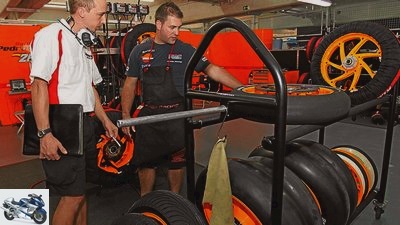
2snap
Sports & scene
Motorsport
Tires in MotoGP
Tires in MotoGP
The price of the unit
Content of
Years ago, as the MotoGP organizer, Dorna issued rules for uniform tires in order to end the tire dispute and create equal opportunities. This has not really worked out – until now.
Uwe Seitz, Mat Oxley
04/22/2014
MotoGP standard tires have been around for six seasons. So for six World Cup years the same rules and one manufacturer: Bridgestone. For decades, the Grand Prix was tasked with designing tires that would work for motorcycles. Since the standard tires it is exactly the other way around. Since there is only this one tire, all motorcycles have to be tailored to it, the bikes have to be developed in such a way that they get the best possible grip from the rubber. Whoever succeeds in this passably enough becomes world champion.
Buy complete article
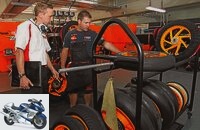
Tires in MotoGP
The price of the unit
4 pages) as PDF
€ 2.00
Buy now
“In the end, it all depends on how well the bike can handle the tires, because you have to awaken the right forces to get the tire to work,” explains Suzuki MotoGP engineer Tom O’Kane. “You can see how the bike design of all manufacturers is developing in a certain direction: in order to be able to use the latest standard tires as effectively as possible. It’s a loop, because the tires keep changing and the motorcycles adapt. If you can’t do that, you can’t be quick. “
Only the unit wheels are to blame
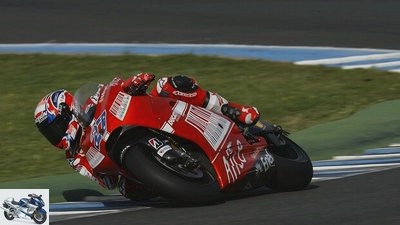
2snap
Casey Stoner won the MotoGP World Championship with the Bridgestone Slick for Ducati in 2007, after the standard tire regulation in 2009, the Italians failed to develop the Desmosedici for the Bridgestones. Stoner switched to Honda and became world champion again.
Ducati blames the problems that have plagued them since 2009, the failure to develop the Desmosedici towards the one-size-fits-all tire. These are completely different from the Bridgestone slicks with which Ducati and Casey Stoner became world champions in 2007.
A homemade problem for the Italians, because the tires at Honda and Yamaha work largely flawlessly (at least most of the time). Unless one believes the conspiracy theory that the Japanese tire manufacturer builds the standard tires specifically for Honda and Yamaha in order to be able to be sure that both companies have their millions of production motorcycles with OE tires from Bridgestone equip. A rather flat accusation, because the Honda RC 213 V and the Yamaha M1 are vastly different motorcycles, which makes it virtually impossible for Bridgestone to accommodate both and to be able to build a tire that works the same on the M1 and RC 213 V..
New rear tire, old discussions
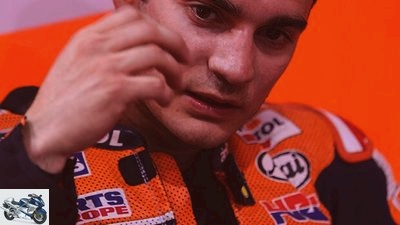
2snap
“The chattering was awful. For us that meant eating shit for a year”, Dani Pedrosa, Honda works driver.
This year nothing has changed on the front tire compared to 2012, when the softer slick was developed for more feel at the front. The big development in 2014 concerns the rear tire. For a few years – especially from 2010 to 2012 – Bridgestone had to take a lot of criticism from the drivers because the rear tire was difficult to get up to temperature and it was difficult to maintain it over long periods of time. Valentino Rossi was the most prominent victim of this trait when he broke his leg in Mugello in 2010 after briefly taking the gas off and the tire cooling down quickly. Last year, Bridgestone finally seemed to have the issues under control. The 2013 slick warmed up much faster, which took a lot of the risk of falling over the first few laps. But then came the Phillip Island disaster, where the tire manufacturer had to face the worldwide ridicule of building a racing tire that could not even survive half a race.
Bridgestone will do everything in their power to never concede an own goal like this again. That’s why the 2014 rear tire is more resistant to very high temperatures – an unavoidable phenomenon on MotoGP bikes that are faster, stronger and heavier than ever before. Even so, it still has to get hot fast enough.
Who needs what The argument goes on and on
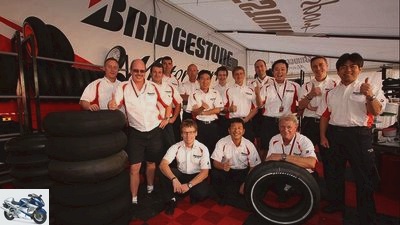
2snap
The GP team of the standard tire manufacturer consists mainly of Germans. Ex-GP driver Steve Jenkner will also be there again.
But as always in racing, everything is impossible! Anyone who increases performance in one place has to take it away in another. In this case, the new, harder construction reduces the possibility of deformation of the tire on the sidewall, which reduces the contact surface there and thus the grip in large lean angles. That in turn hits some drivers harder than others – most certainly Jorge Lorenzo, who drives extremely fast in large lean angles almost through the entire curve. “Bridgestone wants to take risks in no time, this time they are perhaps too conservative,” says the 2010 and 2012 world champions. “The rear tire is now very stiff on the side. That’s good for Honda and bad for Yamaha, especially for me because I need high cornering speed. The Yamaha is reluctant to turn when you slide the throttle on it. Then she even understeers. Poor side grip is now a real problem. Overall performance is important, of course, but we have more problems with the tire than with the one from 2013. What worries me most is safety. I’ve never risked more when accelerating than I do now, ”reports Lorenzo.
Bridgestone obviously hears his criticism. A revised rear tire is said to have been developed by the French GP in Le Mans in May. Bridgestone listened to Lorenzo’s feedback, it is said, but also to criticism from other drivers who noticed that the new tire slows their cornering speed. For the second GP of the season in Austin there was therefore also the tire from 2013 – allegedly due to production difficulties with the 2014 model. Some drivers disagree with these developments. If the new tire causes Yamaha more difficulties than Honda, it is not surprising that the Honda drivers no longer want any changes. Again, there were conspiracy allegations when the 2013 tires arrived in Austin, designed to bring back the lack of lateral grip on the Yamahas. So notice: The greatest achievement of standard tires – they are manna for the wildest rumors.
MotoGP needs bigger chances of victory
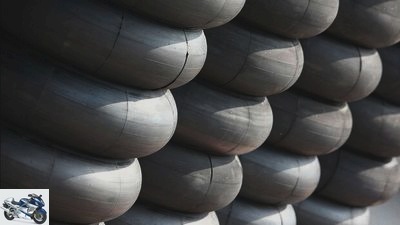
2snap
Not everyone can be satisfied with the standard tires.
Honda now wonders why Bridgestone didn’t listen to their complaints when the soft front tire was introduced in mid-2012 and caused them such problems, while Yamaha was very happy with it. Stoner would probably have snatched the title away from Lorenzo at the time if he had been allowed to drive with the previous tire. Stoner’s teammate at the time, Dani Pedrosa, still remembers how he struggled with the new tire: “We suddenly had terrible chattering, we had to eat shit all year,” said the former 125 and 250 world champion. That is the second point about standard tires: everyone will never be satisfied with it.
It takes an exceptionally talented driver to ignore everything that brings us to Marc Márquez. Last year only a few drivers managed to use the hard duo-compound tire to the full over the entire race distance. In fact, Marquez was the only top rider to use this tire and win a race with it in 2013. His aggressive driving style is the only thing that gives him the right temperature, while others don’t get enough grip with it. In fact, its brutal corner entry and exit maneuvers are too much for the soft tire. This was also evident in Qatar 2014: Márquez was the only one to drive the hard variant – and won. “I made up my mind at short notice. My mechanics looked at me in horror, but I said we’d give it a try and see what happens. In the last lap I had a small advantage, ”said the reigning world champion.
Here and there, Márquez will be able to use this tough tire for himself. On other routes, where the tire temperatures are lower, the other drivers may have an advantage. Less aggressive courses therefore favor the riders of the new open-class bikes because they can ride one step softer. These rules are intended to give all drivers greater chances of victory – and the MotoGP World Championship needs that more urgently than ever. If the circumstances are right, you have to have Aleix Espargaro with the old 2013 M1 on your radar. And that is the third characteristic of the standard tires: It remains exciting.
2014 tires in MotoGP
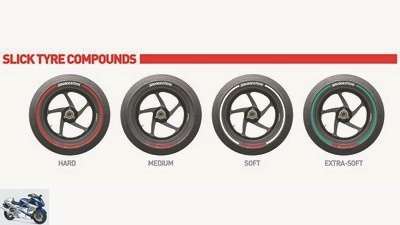
Bridgestone
The Bridgestone standard tires for MotoGO 2014.
Full hardness
The hardest tire has a red ribbon this year – always. Before that, there were different mixtures from race to race, regardless of whether the factory or CR team, of which only the soft one wore a white ribbon.
Middle thing
The unmarked tires are the medium slicks. With higher temperatures on the day of the race, the works teams have to choose between black and red. The first laps will be difficult with red
White flag
If it’s cool or on narrow tracks where the tires don’t get quite as hot, the softest slick will be used by the works teams. The important thing here is how the tire degrades in the end.
Green band
This tire is not available to the factory teams. The extra-soft slick serves the open class and enables fast lap times. If it is too successful, it can be withdrawn from teams like Ducati.
Related articles
-
2snap 24 pictures 2snap 1/24 2snap 2/24 2snap 3/24 2snap 4/24 2snap 5/24 2snap 6/24 2snap 7/24 2snap 8/24 2snap 9/24 2snap 10/24 2snap 11/24 2snap 12/24…
-
Kirn 10 pictures Kirn 1/10 Kirn 2/10 Kirn 3/10 The pillars of Bridgestone MotoGP engagement: MOTORRAD interview partner Thomas Scholz (front) and his…
-
Six super sports tires in a comparison test
markus-jahn.com 16 pictures markus-jahn.com 1/16 When it is wet, there is only a fine line between grip and take-off. Good skins offer a wide range of…
-
Gold and Goose Sports & scene Casey Stoner – MotoGP star Portrait: Casey Stoner The dominator of the 2011 MotoGP season Content of A country egg at…
-
Motorsport Grid Girls MotoGP Superbike World Championship IDM 2018
2snap 72 pictures Eisele 1/72 We would like to start with three pretty ladies from the IDM. These recordings were made during the race in Schleiz. 2snap…
-
Spotlight: The dispute over compulsory winter tires
archive counselor traffic & business Spotlight: The dispute over compulsory winter tires Focus: compulsory winter tires The dispute over mandatory winter…
-
Enduro tires tested 110-80 R 19, 150-70 R 17
markus-jahn.com 34 pictures markus-jahn.com 1/34 Enduro riding … markus-jahn.com 2/34 Especially during the wet test, the GS rolled out with a…
-
Best purchase for sports tires (MOTORRAD 13-2013)
Jahn 23 pictures Jahn 1/23 The 2013 MOTORRAD sports tire test. Jahn 2/23 The sports tires on the country road and motorway. Jahn 3/23 Where did the…
-
Repair motorcycle tires or not. What is allowed?
5 pictures 1/5 Annoying: screw in the tire and no more inflation pressure. Repairing is legally and technically possible. 2/5 Breakdown assistance…
-
Recommended tires size 120-70 ZR 17 and 180-55 ZR 17
accesories tire Recommended tires size 120/70 ZR 17 and 180/55 ZR 17 Recommended tires size 120/70 ZR 17 and 180/55 ZR 17 Play it safe Anyone who loses…